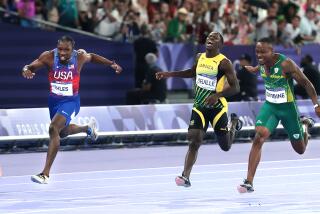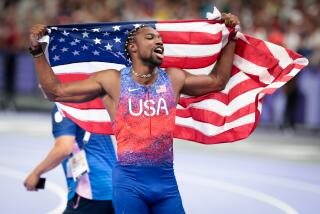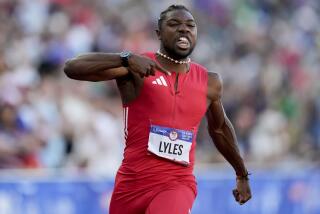How does Usain Bolt do it?
Jamaican sprinter Usain Bolt hardly fits the physical profile of most of his peers. At 6-feet-5, he towers over most other shorter, stockier runners. This seems to work for the 23-year-old Bolt, who recently set world records in the 100 meter and 200 meter races at the 12th World Track and Field Championships in Berlin.
Why he’s faster than his cohorts, despite being significantly taller, is the subject of much speculation among coaches, exercise physiologists and geneticists.
“Most sprinters are pretty small people,” says Carl Foster, a professor in the department of exercise and sports science at the University of Wisconsin-La Crosse. “It’s a mechanical thing -- runners have got to be able to generate the power to accelerate a body, and a bigger body is harder to accelerate than a smaller one.”
It’s a simple law of physics -- it takes more energy to move a larger mass than a smaller one. But somehow Bolt manages to make his larger, longer legs move as fast as those of his shorter competitors.
Foster and other experts say that various factors (none of which seem to involve an affinity for chicken nuggets) could contribute to Bolt’s success. It goes to show, they add, that sprinting is much more complex a sport than simply running as fast as you can.
One thing Bolt has going for him, besides his longer stride length, is that he doesn’t lose energy toward the end of a race.
Corey Hart, an exercise physiologist with the Physio Performance Lab in Boise, Idaho, chalks that up to Bolt’s dorsiflexion, the way the foot flexes toward the shin, while walking or running. This may predispose him not to put his heel too close to the ground, which would make him lose energy.
“Sprinters run on their forefeet,” he says. “When you think about sprinting, you resist the force that goes into the ground by not putting the heel down.”
Dan Cipriani, a professor of exercise science at San Diego State University, thinks one of the keys to Bolt’s success may lie in what he does specifically during push-off, when his foot is in plantar flexion, or the movement of the foot away from the shin -- the opposite of dorsiflexion. “The way he’s able to propel himself forward, I would assume he has very good plantar flexion strength and speed.”
Bolt also might be doing something more efficient with his upper body, which is extremely important for sprinters and helps maintain efficiency in the forward movement, Cipriani says. “If you’re not using your upper body correctly, it could force the pelvis to rotate sideways more than straight ahead.”
Still, Cipriani wonders how Bolt is able to move his joints fast enough to be on a par with his peers. Legs are like levers, and shorter levers are going to move more quickly than longer ones. Bolt’s long legs should also be a disadvantage in starting, he adds, since they may make it more difficult to gain speed quickly.
How much of Bolt’s speed can be credited to genetics and how much to training may never be known. Some speculate that Bolt may have the ACTN3 gene, also known as the speed gene. Studies have shown that many power athletes have this gene, which allows the body to produce a specific muscle protein that aids in activities such as sprinting. “There’s no question in my mind that he’s going to have a convergence of certain genetics that contribute to his success,” says Martin Munzer, president and chief executive of CyGene Laboratories Inc., a Florida-based biotechnology company offering genetic testing for consumers. “But that’s not the only reason he’s successful. There are all kinds of factors that play into that, by either coincidence or purpose.”
Besides, Munzer adds, genes don’t tell the whole story. “Just because you have a certain genetic profile it doesn’t predestine you to anything. You can affect the existing genes by switching them on and off through dietary or environmental effects, like smoking.”
While analyzing Bolt’s running gait or gazing into his gene pool might ultimately help us understand what makes a runner fast, there may be something else to learn from Bolt’s accomplishments: Body type doesn’t always dictate who will do well in a certain sport. Some coaches tend to look for specific body types to be good fits with certain sports -- and maybe they shouldn’t be pigeon-holing young athletes that way, Foster says. “This probably argues that you should have children do as many activities as they can.”
--
More to Read
Go beyond the scoreboard
Get the latest on L.A.'s teams in the daily Sports Report newsletter.
You may occasionally receive promotional content from the Los Angeles Times.








